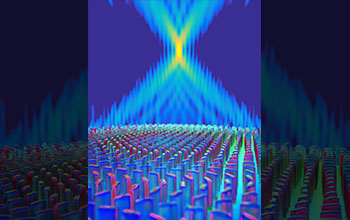Multimedia Gallery
Meta-lens records at smaller than a wavelength of light
A schematic exhibiting an ultra-thin meta-lens created by researchers at Harvard University. The lens is made of titanium dioxide nanofins on a glass substrate. In the schematic, the meta-lens focuses an incident light (penetrating from bottom and propagating upward) to a spot (yellow space) smaller than the incident wavelength.
More about this image
Researchers at the Harvard John A. Paulson School of Engineering and Applied Sciences (or SEAS) have found a way to create the very first planar lens that works very efficiently within the visible spectrum of light. This completely covers the entire range of colors from red all the way to blue. The new lens is able to resolve nanoscale features that are less than a wavelength of light apart from one another using an ultra-thin array of teeny waveguides, called a metasurface, that bend light as it passes through. Potential applications for the new technology include wearable optics for virtual reality.
The fabrication work was carried out at the Harvard Center for Nanoscale Systems, which is supported by the National Science Foundation.
The researchers say the technology holds the potential of being quite revolutionary since it works within the visible spectrum, which means it has the ability to replace lenses on a wide range of devices.
To learn more about this research, see the Science News Journal story Meta-lens able to record at smaller than a wavelength of light. (Date image taken: May 2016; date originally posted to NSF Multimedia Gallery: Dec. 14, 2016)
Credit: Peter and Ryan Allen; courtesy of professor Federico Capasso, SEAS/Harvard University; copyright Harvard University
Images and other media in the National Science Foundation Multimedia Gallery are available for use in print and electronic material by NSF employees, members of the media, university staff, teachers and the general public. All media in the gallery are intended for personal, educational and nonprofit/non-commercial use only.
Images credited to the National Science Foundation, a federal agency, are in the public domain. The images were created by employees of the United States Government as part of their official duties or prepared by contractors as "works for hire" for NSF. You may freely use NSF-credited images and, at your discretion, credit NSF with a "Courtesy: National Science Foundation" notation.
Additional information about general usage can be found in Conditions.
Also Available:
Download the high-resolution JPG version of the image. (6.2 MB)
Use your mouse to right-click (Mac users may need to Ctrl-click) the link above and choose the option that will save the file or target to your computer.

